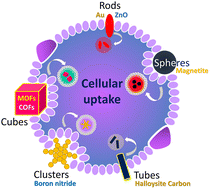Effects of morphology and size of nanoscale drug carriers on cellular uptake and internalization process: a review
Abstract
In the field of targeted drug delivery, the effects of size and morphology of drug nanocarriers are of great importance and need to be discussed in depth. To be concise, among all the various shapes of nanocarriers, rods and tubes with a narrow cross-section are the most preferred shapes for the penetration of a cell membrane. In this regard, several studies have focused on methods to produce nanorods and nanotubes with controlled optimized size and aspect ratio (AR). Additionally, a non-spherical orientation could affect the cellular uptake process while a tangent angle of less than 45° is better at penetrating the membrane, and Ω = 90° is beneficial. Moreover, these nanocarriers show different behaviors when confronting diverse cells whose fields should be investigated in future studies. In this survey, a comprehensive classification based on carrier shape is first submitted. Then, the most commonly used methods for control over the size and shape of the carriers are reviewed. Finally, influential factors on the cellular uptake and internalization processes and related analytical methods for evaluating this process are discussed.

- This article is part of the themed collection: 2022 Reviews in RSC Advances


 Please wait while we load your content...
Please wait while we load your content...